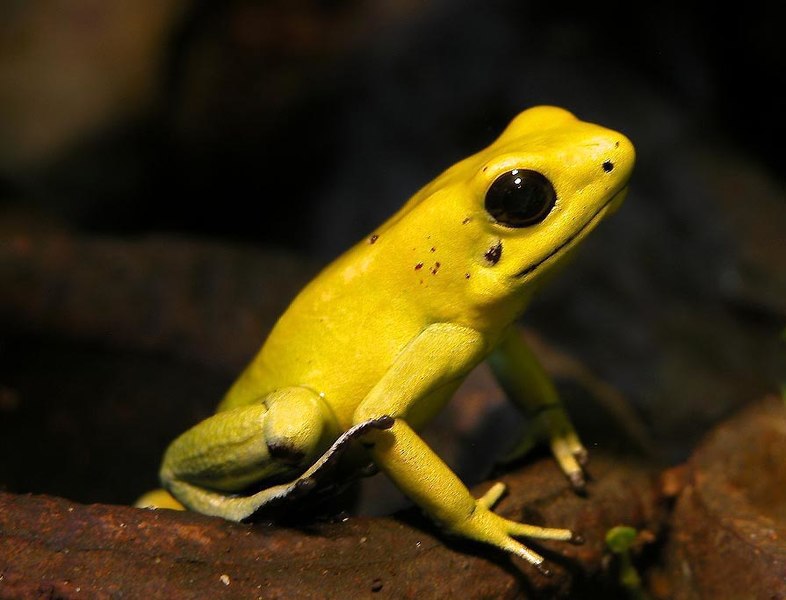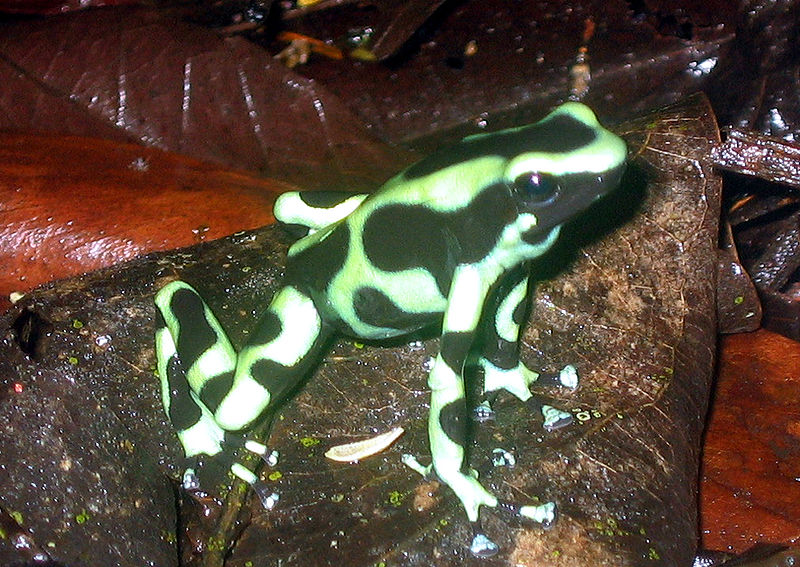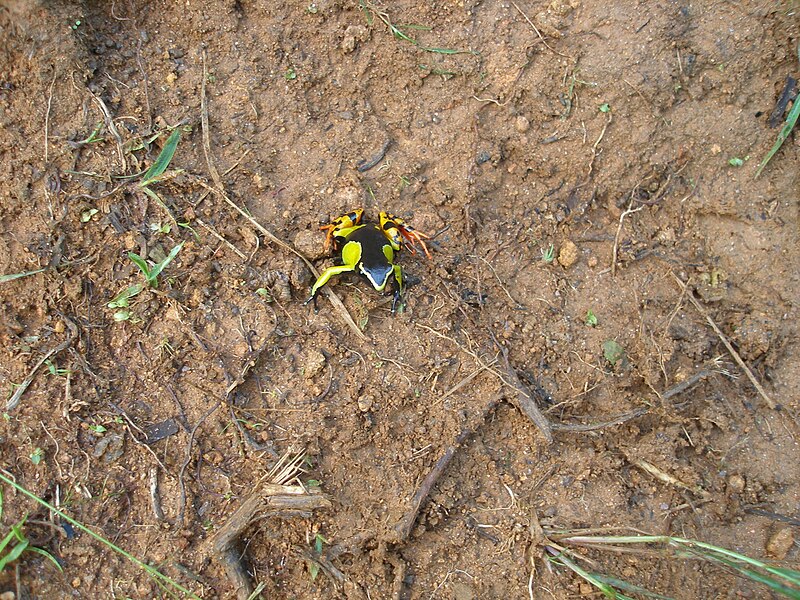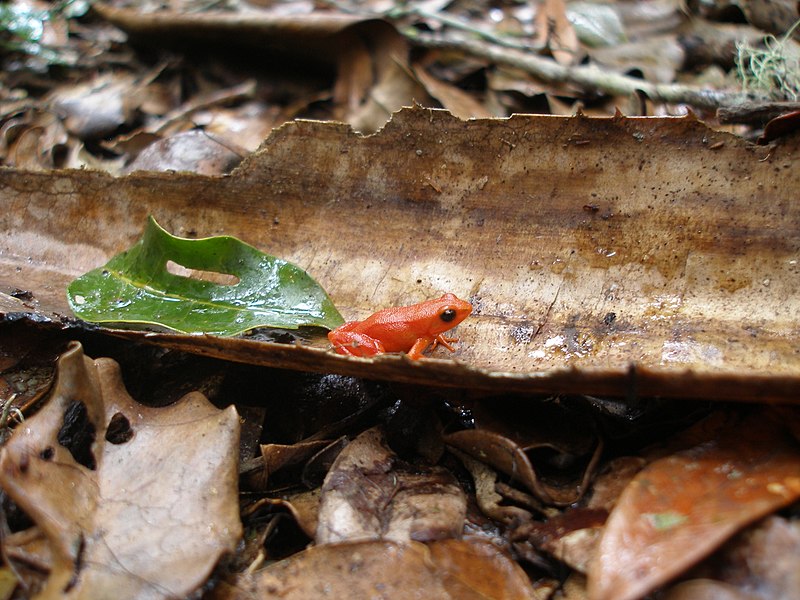Central and South American frogs of the family Dendrobatidae secrete virulent skin toxins (histrionicotoxins, batrachotoxins and others) when disturbed. Many people believe that the toxins of many species of Poison Frogs, known also as “Poison Arrow Frogs” and “Dart Poison Frogs”, were once used to coat darts and arrows used in hunting and warfare. Actually, this is not the case – but the actual facts are no less interesting.
Origin of Frog Toxins
Poison Frog toxins are derived from the diet, being concentrated and synthesized from chemicals within the ants and millipedes (and possibly other invertebrates) upon which the frogs feed. Wild-caught frogs gradually lose their protective toxins after a time in captivity… captive-born Poison Frogs do not develop toxic skin secretions unless they are fed the appropriate types of invertebrates.
Some years ago, I was fortunate enough to be at the National Aquarium in Boston when the origin of Poison Frog toxins was being investigated. In one experiment, Green and Black Poison Frogs (Dendrobates auratus) that had lost their skin toxicity were liberated in the aquarium’s huge rainforest exhibit. When recaptured some time later, the frogs had regained their potent skin toxins. Studies showed that the source of these toxins were invertebrates that had been transported to the exhibit in soil and on tropical plants.
Toxin Use in Hunting
The use of frog toxins on hunting darts was first reported in the literature in 1823, by British naval captain C. Cochrane. He reported that certain forest-dwelling people collected Golden Poison Frogs (Phyllobates terribilis) and confined and fed the frogs until toxins were needed. The frogs were pierced with a stick in order to induce the secretion of the toxins, which appeared as white froth on the skin.
Up to 50 darts could be treated with the secretions from a single frog, and the darts were reported to retain their potency for at least 1 year. A jaguar shot with a poison-coated dart was said to die within 4-5 minutes, and monkeys and smaller animals were killed instantly.
Darts, and not arrows, were utilized for hunting…toxin use on arrows shot from bows has never been observed.
Toxins were used in this manner by the Mucushi, Chaco and, possibly, other groups of people.
Toxins and Warfare
It comes as a surprise to many folks that frog toxins have never been documented as being used in wars or against human enemies.
Frog Species Utilized
 The skin secretions of only 3 species of frog have been identified as being used as dart coatings. These frogs are not, as often believed, the familiar Dendrobates species, but rather belong to the related genus Phyllobates. Frogs belonging to this genus are less commonly seen in the pet trade than Dendrobates, although one, the Golden Poison Frog (P. terribilis), is fairly well-established in captivity.
The skin secretions of only 3 species of frog have been identified as being used as dart coatings. These frogs are not, as often believed, the familiar Dendrobates species, but rather belong to the related genus Phyllobates. Frogs belonging to this genus are less commonly seen in the pet trade than Dendrobates, although one, the Golden Poison Frog (P. terribilis), is fairly well-established in captivity.
Medicines from Frog Skin
The skin toxins of a great many frogs, related and unrelated to the Dendrobatids, are highly complex and are being studied with a view towards developing medications that may be useful in oncology and infectious disease research. A compound derived from the secretions of the Phantasmal Poison Frog (Epipedobates tricolor) shows great promise as a pain medication…it is more effective than morphine, non-addictive and non-sedating.
Further Reading
You can read more about studies on the medicinal value of frog toxins here.
Golden Poison Frog image referenced from wikipedia and originally posted by Wilfried Berns
 Poison Frogs (also known as Dart or Arrow Poison Frogs) exhibit an amazing array of colors and patterns – some so spectacular as to appear unreal. What’s more, they are active by day, exhibit complex social behaviors, and care for their tadpoles in “mammal-like” fashion…and are not at all shy about doing so. Small wonder they are among the most desirable of all amphibian pets! Once considered delicate captives, Poison Frogs are now regularly bred in captivity and may live to age 15 or beyond.
Poison Frogs (also known as Dart or Arrow Poison Frogs) exhibit an amazing array of colors and patterns – some so spectacular as to appear unreal. What’s more, they are active by day, exhibit complex social behaviors, and care for their tadpoles in “mammal-like” fashion…and are not at all shy about doing so. Small wonder they are among the most desirable of all amphibian pets! Once considered delicate captives, Poison Frogs are now regularly bred in captivity and may live to age 15 or beyond. That Reptile Blog – Reptile, Amphibian and Exotic Pet Care and Information
That Reptile Blog – Reptile, Amphibian and Exotic Pet Care and Information

 The skin secretions of only 3 species of frog have been identified as being used as dart coatings. These frogs are not, as often believed, the familiar Dendrobates species, but rather belong to the related genus Phyllobates. Frogs belonging to this genus are less commonly seen in the pet trade than Dendrobates, although one, the Golden Poison Frog (P. terribilis), is fairly well-established in captivity.
The skin secretions of only 3 species of frog have been identified as being used as dart coatings. These frogs are not, as often believed, the familiar Dendrobates species, but rather belong to the related genus Phyllobates. Frogs belonging to this genus are less commonly seen in the pet trade than Dendrobates, although one, the Golden Poison Frog (P. terribilis), is fairly well-established in captivity. Madagascar’s Mantellas or Golden Frogs (Family Mantellidae) are, in many ways, the ecological equivalents of Latin America’s Poison Frogs (Family Dendrobatidae), and illustrate nicely the concept of convergent evolution – unrelated animals from different parts of the world that have developed similar adaptations. Although less commonly kept than the poison frogs, these tiny, brilliantly-colored gems are gaining in popularity. Following is a brief overview of the group.
Madagascar’s Mantellas or Golden Frogs (Family Mantellidae) are, in many ways, the ecological equivalents of Latin America’s Poison Frogs (Family Dendrobatidae), and illustrate nicely the concept of convergent evolution – unrelated animals from different parts of the world that have developed similar adaptations. Although less commonly kept than the poison frogs, these tiny, brilliantly-colored gems are gaining in popularity. Following is a brief overview of the group. Mantella reproductive strategies roughly follow those of the Poison Frogs. Males call during the day from exposed sites on land – light markings on the vocal sacs may serve as a visual stimulus to females. They wrestle for dominance, with the loser being flipped onto his back but otherwise unharmed. Ten to thirty eggs, which are fertilized externally, are deposited in nests below leaf litter.
Mantella reproductive strategies roughly follow those of the Poison Frogs. Males call during the day from exposed sites on land – light markings on the vocal sacs may serve as a visual stimulus to females. They wrestle for dominance, with the loser being flipped onto his back but otherwise unharmed. Ten to thirty eggs, which are fertilized externally, are deposited in nests below leaf litter.